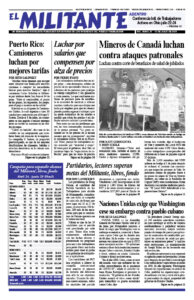Despite a brutally enforced ban by Moscow, which has occupied the Crimean Peninsula since 2014, Tatars did come out into the streets May 18 one by one. Many were holding signs commemorating the 77th anniversary of the mass deportation of the Crimean Tatar population hundreds of miles away to Central Asia and Siberia, under slanderous charges by Joseph Stalin that the entire people were agents of Nazi Germany.
Protesters held handmade signs declaring, “No to the deportation of the Crimean Tatars into the prisons of the Russian Federation” and “May 18 continues to this day.” They were pointing to both what happened in 1944 and to continuing moves by Moscow to transfer hundreds of Tatars to Russia for show trials, torture and imprisonment.
Tatars and their supporters also demonstrated in cities outside Crimea, including London and Brussels. Commemorations took place in Ukraine, where many Crimean Tatars have relocated since Russian President Vladimir Putin seized the peninsula, and Ukrainian authorities opened a photo exhibit on the 1944 mass deportation.
On June 26, Tatars in Ukraine commemorated the 30th anniversary of Crimean Tatar Flag Day, which is also banned in Crimea. Tatars, other Ukrainians and exiled members of the Mejlis — the national leadership of the Crimean Tatars — carried a 52-by-30-foot flag on a 10-day marathon throughout Ukraine, ending in Kyiv. A rally was held on Maidan Independence Square June 26, followed by a procession down Kyiv’s main street, and a concert titled “Two Flags — One Country.”
The Maidan was the popular mobilization that ousted the Moscow-backed Ukrainian government of Viktor Yanukovych in 2014.
The Crimean Tatar flag was adopted in 1917 by the first Tartar National Congress, or Qurultay. After being crushed under Stalinist repression a decade later, the Mejlis was banned, and wasn’t reinstated until June 26, 1991. Its longtime leader Mustafa Dzhemilev, who had been imprisoned by Stalin, participated in the commemoration, as did current Mejlis chairman Refat Chubarov. Both are banned by Moscow from going back to Crimea.
With the collapse of the Soviet Union in 1991, many Tatars were able to return to Crimea and fought to regain their homes and reestablish their cultural heritage. But after the Russian government seized the peninsula in 2014, and cracked down on all opposition, the Russian Federal Security Service and other police forces raided the Mejlis headquarters, homes, mosques and schools. Then they banned the Mejlis, which had organized thousands to protest Moscow’s occupation.
The June 26 celebrations also mark the birthday of Emir-Usein Kuku, a Crimean Tatar human rights activist framed up and imprisoned in Russia for the last six years. He and more than 100 Tatar Muslim prisoners are incarcerated on “terrorism” charges for their political activity.
Last fall Kuku issued a statement from prison, saying, “We Crimean Tatars have always remembered and will never forget that Crimea is our land. We did not give it to Russia, nor did we sell it.
“We, the people, did not recognize and will not recognize as legal the occupation and annexation of Crimea by Russia, neither in 1783 [when the Russian czarist regime seized Crimea], nor in 2014 and now.”
After the 1917 Bolshevik Revolution, the Tatars established an autonomous socialist republic in the newly formed Soviet Union, as did the Ukrainians. Use of their native languages and culture flourished and national pride grew. Revolutionary leader Vladmir Lenin’s proletarian internationalist course supported the right of all peoples oppressed by the czar’s “prison house of nations” to self-determination.
Under Lenin, Tatars flourished
In “A Struggle for Home: The Crimean Tatars,” a 2016 documentary by Christina Paschyn, narrator Brian Glyn Williams explains that “one of the periods Crimean Tatars flourished the most” was in the 1920s when “Vladimir Lenin recognized the Crimean Tatars as Crimea’s native population.”
Williams explains that under the Bolsheviks, the Tatars had control of their own parliament, schools, police and other institutions; practiced their own language; and women gained the right to vote. “Crimean Tatars benefited from communist rule,” he says.
“But,” the film explains, “this golden age came to an end when Joseph Stalin rose to power.”
In the late 1920s, a growing Soviet bureaucratic caste, led and epitomized by Stalin, carried through a bloody counterrevolution against the policies of the Bolsheviks. National rights were trampled on, in Crimea, Ukraine, and elsewhere across Russia. Famine stalked the land as Stalin carried out a forced collectivization that led to widespread starvation.
In the 1944 deportation more than 200,000 Tatars were exiled, most transported in filthy, freezing and suffocating box cars. Some 46% died on the forced journey or within the first two years of exile.
Moscow organized a Russification program in Crimea, relocating thousands of native Russians on land and homes left vacant by the Tatars’ deportation.
That “was a day that indeed turned the entire history of the Crimean Tatar people upside down, and sent them decades, if not centuries, back. After all, this was no mere resettlement, but an operation aimed at the destruction of a people,” Mustafa Dzhemilev told the Kharkiv Human Rights Protection Group May 18. “Yet, we do not speak of the deportation out of a desire to avenge what was done to our people. We remind people of it so that nothing like this is ever repeated.”

